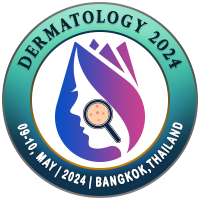
Selma Bakar Dertlioglu
Dr. Selma Bakar Dertlioglu Dermatology Clinic, TurkeyTitle: The treatment of vitiligo is currently very difficult
Abstract
Aims: The aim of the present study was to determine the efficacy and safety of narrow-band UVB (NB-UVB), topical pimecrolimus, topical tacrolimus and topical methylprednisolone aceponate in the treatment of vitiligo.
Methods: A total of 88 patients with vitiligo were enrolled in this study. The patients were divided into four groups: NB-UVB phototherapy (22), 1% pimecrolimus cream (22), 0.1% tacrolimus ointment (22), methylprednisolone aceponate cream (22). The activity of each vitiligo lesion was assigned a VIDA score from -1 to +4 at baseline, as well as 2,4,8,12, and 24 weeks for the whole period of therapy. The patients were examined using digital photographs, and the measurement of the efficacy of treatment was based on the percentage and score of repigmentation of all scored lesions.
Results: In the 4th treatment week, the methylprednisolone aceponate group was found to have significantly higher repigmentation percentages and scores compared with the pimecrolimus group (p=0.023, p=0.021, respectively). In the 8th week of treatment, the highest repigmentation percentage was obtained in the NB-UVB group. The most robust treatment responses in the patients with acral involvement were achieved with the NB-UVB and methylprednisolone aceponate therapies; in the patients with generalized involvement, the most robust treatment responses were achieved with the NB-UVB therapy.
Conclusion: Methylprednisolone aceponate produced a prompt treatment response, but both methylprednisolone aceponate and NB-UVB treatment had the same long-term efficacy and produced more robust responses than pimecrolimus and tacrolimus.
Biography
WILL BE UPDATED SOON

